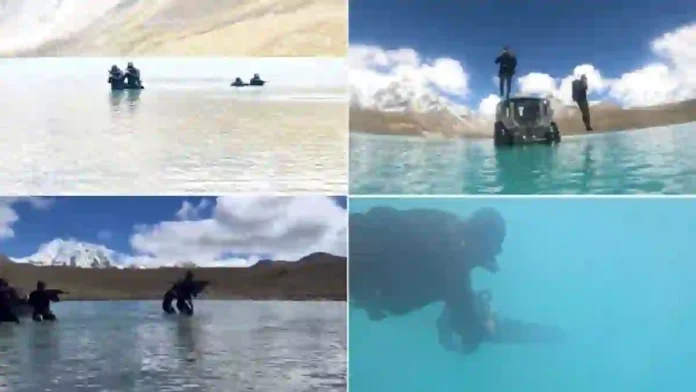The Indian Army PARA (Special Forces) and Indian Navy Marine Commandos (MARCOS) recently carried out an unprecedented joint Scuba and Combat Diving Exercise in Sikkim, marking a significant demonstration of high-altitude endurance training and inter-service cooperation. Conducted between 30 August and 05 September 2025 at a staggering altitude of 17,000 feet, the exercise was aimed at honing the operational readiness of India’s most elite special operations forces in one of the world’s harshest combat environments.
Over the course of a week, participants faced extreme sub-zero temperatures, thinning oxygen levels, and freezing waters while executing a demanding series of underwater combat and tactical diving operations.
Read- Su-30 Undergoes 100 HAL-Driven Modifications, BrahMos Integration A Key Milestone: HAL CEO
The drills included open circuit air diving — crucial for conventional underwater missions — and closed circuit pure oxygen diving, which enables stealth insertion without leaving detectable bubbles.
Soldiers also carried out dives up to 17 metres in near-freezing glacial waters, alongside night combat diving operations designed to simulate real-world infiltration missions where visibility and environmental conditions are severely restricted.
The challenging combination of high-altitude rarefied atmosphere and icy mountain waters pushed combat divers to the limits of human physical endurance and psychological resilience.
According to a senior defence official, the unforgiving terrain and treacherous conditions not only tested stamina and underwater proficiency but also strengthened adaptability, tactical precision, and interoperability between the services.
Training under such extreme conditions is rarely conducted at such altitudes anywhere in the world, and the exercise set a new benchmark by showcasing how India’s special forces are preparing to seamlessly transition between environments as disparate as Himalayan glaciers and oceanic depths.
Read- India Targets 200-Plus Warships, Submarines By 2035 To Counter Pak-China Naval Threats
Beyond individual skills, the exercise placed strong emphasis on jointmanship, bringing together the specialised diving and operational expertise of MARCOS with the mountain warfare and unconventional combat proficiency of PARA (SF).
The week-long training also underscored the critical role of integrated special operations in India’s evolving security architecture.
In the face of multi-domain challenges, including potential cross-border contingencies in mountainous regions and maritime security threats, the ability of PARA (SF) and MARCOS to work in unison ensures that India retains a decisive edge in diverse theatres of conflict.
The skill sets reinforced during the exercise prepare operators for a wide spectrum of missions, from covert reconnaissance and sabotage to high-risk rescue and rapid-response interventions under drastically challenging conditions.
The Team Commander, reflecting on the experience, emphasised that such exercises embody the essence of combat preparedness: they sharpen endurance, cultivate mental toughness, and ensure that elite soldiers remain capable of responding effectively in the harshest tactical environments.
He noted that each dive, each mission simulation, and each exposure to adversity expanded the operational confidence of the teams, reaffirming their ability to “operate effectively in any environment, no matter how harsh or demanding.”
The high-altitude combat diving exercise in Sikkim represents both a symbolic and practical stride forward in India’s pursuit of cutting-edge special operations capability.
Not only did it reaffirm the synergy between the Army and Navy’s special forces, but it also demonstrated India’s growing emphasis on multi-terrain readiness, ensuring that its elite commandos remain mission-ready whether in the high Himalayas, dense jungles, deserts, or deep seas.
Beyond battlefield application, the exercise has also set in motion a template for future training modules where cross-domain adaptability and resource-sharing will remain indispensable for securing India’s national interests in an increasingly complex security landscape.
Agencies




